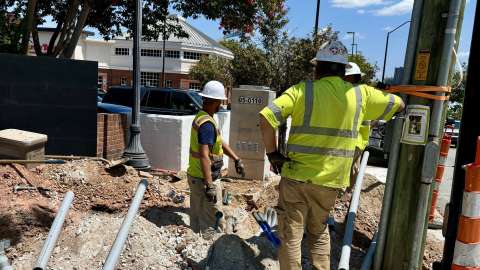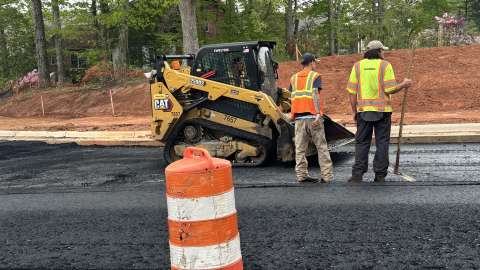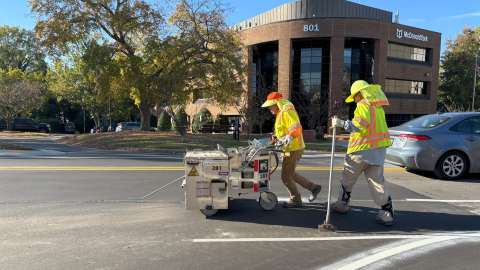Jump To:
Site Preparation
Clearing and grubbing
A process that prepares a site's foundation for construction by removing vegetation and other root structures. Clearing is the process of removing surface material like trees, grass, logs, and other debris from the construction site. Grubbing refers to removing stumps, roots, and other underground systems that remain after clearing.
Why is clearing and grubbing necessary?
- Ensures the construction site is safe and clean.
- Provides an even foundation for the remainder of the construction.
- Prevents environmental issues that could affect the quality of work.
Utility Work
Utility relocation
Most roadway or sidewalk projects require relocating utilities. Utilities like water, sewer, and stormwater pipes are usually found under the roads. Private utilities, such as power, telecommunications, and gas lines, are often in the right-of-way as well.
Relocating private utilities is one of the first steps in a roadway or sidewalk project. Private utility companies handle this work, not the City. After the private utilities are relocated, the City can move forward with construction.
Potholing (daylighting)
Potholing, also known as daylighting, is the process of digging test or small holes to locate underground utilities. This technique is used to locate underground utilities and to identify any leaks, cracks, or damage
Benefits of potholing
- Provides a direct line of sight for contractors
- Helps contractors identify utility locations
- Minimizes potential damage during the excavation process
Paving Process & Paving Operations
The main goal of paving a road is to create a smooth surface for driving. To start the paving process, it's important to have a clean base. This first step, called "demolition," involves removing the old asphalt. This prepares the area for installing the new asphalt pavement.
Asphalt paving process
- Grading - The grading process creates a level roadway foundation to achieve proper elevations before paving.
- Sub-base preparation - Creating a solid base is crucial to the pavement process. Crews add a layer of aggregate material and compact it, creating a sub-base layer that supports the new pavement.
- Proof rolling - A "proof roll" is conducted after adding a sub-base. This practice evaluates the durability of the surface and generally involves a dump truck driving over the surface to identify any soft or weak areas.
- Base course - A base course is applied and serves as the first asphalt pavement layer. The base layer of asphalt usually contains a higher amount of crushed stone in the asphalt mix and would provide a bumpy drive.
- Binder and surface course - The binder layer is applied after the base course and serves as the binder between the base course of asphalt and the final pavement layer. The mix of crushed stone in this layer is finer and provides a smoother drive than the base layer.
- Final surface course - The final layer is the surface course and the pavement's top layer. This layer provides a durable and smooth riding surface for vehicles.
Necessary equipment:
- Dump trucks transport materials for paving operations, including asphalt and stone. The materials are then loaded into the paver machine.
- Asphalt pavers are used to lay asphalt evenly and smoothly. Contractors use these machines to distribute and compact asphalt layers over surfaces.
- Rollers can have either a single or double drum configuration. Vibratory rollers apply impact and pressure to the material, typically asphalt, to ensure it is smooth and densely packed.
Paving operations
Patching
- A process where contractors repair damaged sections of asphalt pavement.
- Patching helps smooth out the roads, making it easier for vehicles to travel without bumps.
- This operation ranges from filling in cracks in concrete to repairing potholes.
Wedging
- Wedging involves using asphalt in a series of variable-depth pavement lifts to join proposed grade surfaces with the existing roadway.
- This process creates a smoother transition between existing pavements to proposed grades for vehicles, especially during traffic lane shifts.
- Through the wedging process, contractors can raise parts of the road to improve sight distance and evens road elevations.
Pavement Markings
Thermoplastic striping
Thermoplastic striping is a pavement marking process, where contractors apply heated thermoplastic material onto a road surface. This is done to create roadway markings and symbols.
The process
- Thermoplastic is typically heated to 400 degrees in a melt kettle.
- A striping truck is used to apply the thermoplastic to the road surface.
- Glass beads are dropped immediately into the thermoplastic; these beads make the stripes more reflective and visible to drivers at night.
Durability
- Thermoplastic striping is highly durable, lasting anywhere between 3-5 years.
- Resistant to fading, chipping, and cracking; depending on weather conditions.
- The air temperature must be at least 55°F to apply thermoplastic properly.




